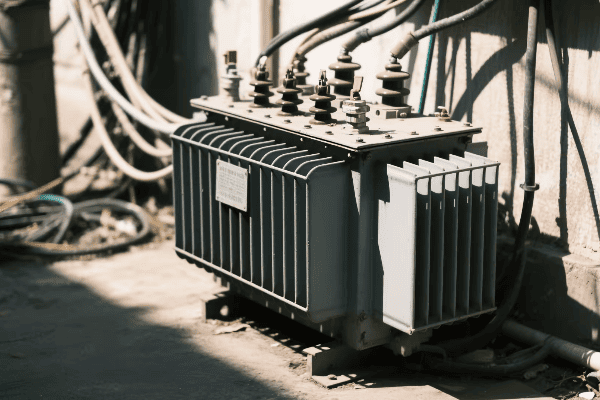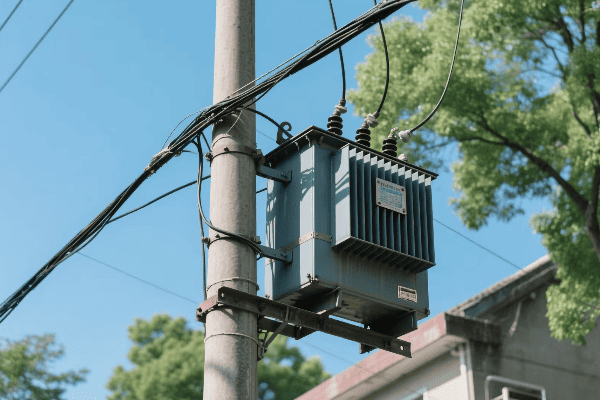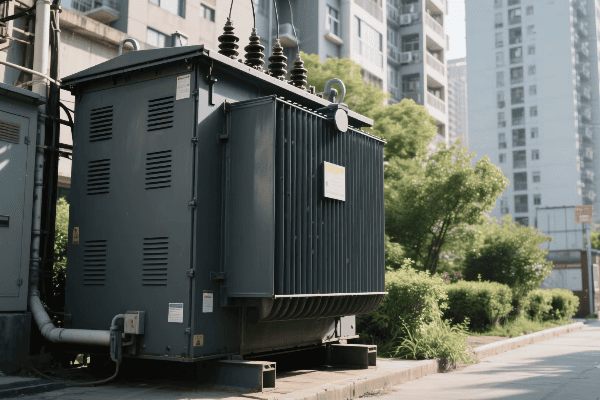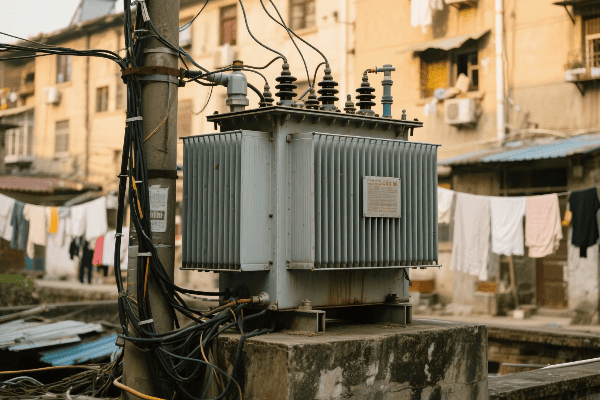Power Distribution Transformer: Energizing Smart Cities with Efficient and Resilient Grid Solutions?
Ever wondered what keeps our bustling cities powered 24/7? The unsung hero of urban energy is the power distribution transformer, quietly revolutionizing our smart city grids.
Power distribution transformers are crucial in energizing smart cities with efficient and resilient grid solutions. They optimize power flow, enhance grid stability, and enable the integration of renewable energy sources, forming the backbone of modern urban power infrastructure.

As someone who’s spent years in the power industry, I’ve witnessed the evolution of these transformers firsthand. Let’s dive into how they’re shaping the future of our urban energy landscape.
Urban Energy Efficiency: Optimizing Power Flow with Advanced Distribution Transformers?
Have you ever considered how cities manage to power millions of homes and businesses without constant blackouts? The secret lies in the advanced distribution transformers optimizing our urban power flow.
Advanced distribution transformers optimize urban power flow by reducing energy losses, balancing loads, and enabling real-time adjustments. These improvements lead to more efficient energy distribution, lower operational costs, and a more reliable power supply for city dwellers.

Let’s break down how these transformers are revolutionizing urban energy efficiency:
Loss Reduction Technologies
Minimizing energy waste:
- Amorphous metal cores reducing no-load losses
- Advanced winding designs to decrease load losses
- Improved insulation materials for better thermal management
Smart Load Balancing
Ensuring stable power distribution:
- Real-time monitoring of power demands across the grid
- Automated load shifting to prevent overloads
- Predictive algorithms for anticipating peak demand periods
Voltage Optimization
Maintaining ideal power quality:
- On-load tap changers for dynamic voltage regulation
- Power factor correction capabilities
- Harmonic mitigation features for cleaner power supply
Energy Monitoring and Analytics
Empowering data-driven decisions:
- Built-in sensors for continuous performance tracking
- Integration with smart grid management systems
- AI-powered analytics for identifying efficiency improvement opportunities
Cooling System Innovations
Enhancing performance and longevity:
- Natural ester fluids for better heat dissipation
- Advanced radiator designs for improved cooling efficiency
- Temperature monitoring and adaptive cooling control
| Feature | Efficiency Benefit | Urban Impact |
|---|---|---|
| Loss Reduction | Lower energy waste | Reduced operational costs |
| Smart Load Balancing | Optimized power distribution | Fewer outages and brownouts |
| Voltage Optimization | Improved power quality | Better performance of sensitive equipment |
| Energy Analytics | Data-driven efficiency improvements | Continuous grid optimization |
| Advanced Cooling | Extended transformer life | Increased grid reliability |
I remember a project where we upgraded a city’s aging transformer network with these advanced models. The utility company was skeptical about the investment, but the results were eye-opening. Within the first year, they saw a 15% reduction in distribution losses. The city’s energy manager told me, "We’re not just saving energy; we’re delivering more reliable power to our residents. It’s a win-win."
Another fascinating experience was implementing smart load balancing in a rapidly growing urban area. The system’s ability to predict and manage demand spikes was remarkable. During a heatwave that would have previously caused brownouts, the grid remained stable. A local business owner remarked, "This is the first summer we haven’t had to worry about power cuts affecting our operations."
These experiences have shown me that urban energy efficiency is about more than just reducing consumption. It’s about creating a smarter, more responsive power distribution system that can adapt to the dynamic needs of a modern city. Advanced distribution transformers are at the heart of this transformation, quietly optimizing power flow and ensuring that our urban centers have the reliable, efficient energy they need to thrive.
Building Resilience: Next-Generation Transformers for Robust City Grids?
Ever wondered how cities keep the lights on during storms or cyberattacks? Next-generation transformers are the unsung heroes building resilience into our urban power grids.
Next-generation transformers enhance city grid robustness through advanced protection systems, self-healing capabilities, and improved durability. These features ensure continuous power supply during extreme events, minimizing downtime and protecting critical urban infrastructure.

Let’s explore how these transformers are fortifying our urban power networks:
Advanced Protection Systems
Guarding against threats:
- Surge arresters for lightning and switching transients
- Cybersecurity features to prevent unauthorized access
- Electromagnetic pulse (EMP) shielding for critical installations
Self-Healing Capabilities
Minimizing downtime:
- Automatic fault detection and isolation
- Rapid reconfiguration to restore power to unaffected areas
- Self-diagnostic tools for proactive maintenance
Extreme Weather Resilience
Withstanding nature’s fury:
- Reinforced enclosures for high wind resistance
- Flood-resistant designs for low-lying urban areas
- Enhanced cooling systems for extreme heat conditions
Smart Grid Integration
Enabling coordinated responses:
- Real-time communication with grid management systems
- Participation in demand response programs
- Seamless integration with distributed energy resources
Redundancy and Modularity
Ensuring continuous operation:
- N+1 redundancy in critical components
- Hot-swappable modules for quick repairs
- Scalable designs to adapt to changing urban needs
| Resilience Feature | Traditional Grid Weakness | Next-Gen Transformer Solution |
|---|---|---|
| Advanced Protection | Vulnerability to surges and attacks | Multi-layered defense systems |
| Self-Healing | Extended outages after faults | Rapid, automated recovery |
| Weather Resilience | Susceptibility to environmental damage | Hardened designs for extreme conditions |
| Smart Integration | Isolated, uncoordinated responses | Networked, adaptive grid management |
| Redundancy | Single points of failure | Fault-tolerant architectures |
I recall a project where we installed these resilient transformers in a coastal city prone to hurricanes. The following storm season put them to the test. While older parts of the grid faltered, the areas with new transformers maintained power. A hospital administrator told me, "Your transformers kept our life-support systems running when we needed them most. You can’t put a price on that kind of reliability."
Another eye-opening experience was implementing a self-healing network in a dense urban area. During a major cable fault that would have previously blacked out several blocks, the system isolated the problem and rerouted power within minutes. A city official remarked, "It’s like the grid has developed its own immune system. We’re seeing a new level of reliability we didn’t think was possible."
These experiences have shown me that building resilience into city grids is about more than just hardening infrastructure. It’s about creating intelligent, adaptive systems that can respond to challenges in real-time. Next-generation transformers are at the forefront of this revolution, providing not just power, but peace of mind to urban dwellers. They’re ensuring that our cities can withstand the unexpected and bounce back stronger, no matter what challenges they face.
Smart City Power Demands: Scaling Distribution Solutions for Growing Urban Needs?
Have you ever considered how cities keep up with ever-increasing power demands? The answer lies in scalable distribution solutions, with transformers at their core.
Scaling distribution solutions for growing urban needs involves implementing flexible, high-capacity transformers that can adapt to changing power demands. These solutions incorporate modular designs, smart load management, and future-proofing features to meet the evolving energy requirements of smart cities.

Let’s dive into how these transformers are meeting the challenge of urban growth:
Modular and Expandable Designs
Adapting to urban expansion:
- Stackable transformer units for easy capacity increases
- Plug-and-play modules for quick installation and upgrades
- Scalable power ratings to match growing demands
Smart Load Management
Optimizing existing infrastructure:
- Dynamic load balancing across multiple transformers
- Predictive load forecasting for proactive capacity planning
- Automated peak shaving to reduce strain during high-demand periods
High-Density Power Solutions
Maximizing power in limited spaces:
- Compact designs for space-constrained urban environments
- High-capacity transformers with smaller footprints
- Underground and vault-type installations for discreet urban integration
Future-Proofing Features
Preparing for tomorrow’s needs:
- Compatibility with renewable energy sources and storage systems
- Support for electric vehicle charging infrastructure
- Upgradable control systems for emerging smart grid technologies
Energy Storage Integration
Balancing supply and demand:
- Built-in interfaces for battery storage systems
- Load leveling capabilities to smooth demand curves
- Support for grid-scale energy storage solutions
| Scaling Feature | Urban Growth Challenge | Transformer Solution |
|---|---|---|
| Modular Design | Unpredictable expansion rates | Easily expandable capacity |
| Smart Management | Fluctuating power demands | Adaptive load distribution |
| High-Density Solutions | Limited urban space | Compact, powerful units |
| Future-Proofing | Evolving technology landscape | Upgradable, flexible systems |
| Storage Integration | Peak demand management | Built-in energy balancing |
I remember a project in a rapidly developing urban area where we implemented a modular transformer system. The city planner was initially skeptical about the higher upfront cost. But as the neighborhood grew, we easily added capacity without major disruptions. Five years later, the planner told me, "Your foresight saved us millions in retrofit costs. We’ve expanded three times without a hitch."
Another fascinating experience was in a tech hub struggling with power quality issues due to rapid growth. We installed high-capacity transformers with smart load management. The system’s ability to balance loads and predict demand spikes was remarkable. A data center manager remarked, "We used to worry about outages during product launches. Now, we don’t even think about power – it’s always there, always stable."
These experiences have shown me that scaling distribution solutions for smart cities is about more than just adding more power. It’s about creating flexible, intelligent systems that can grow and adapt with the city. By implementing these scalable transformer solutions, we’re not just meeting today’s power needs; we’re building a foundation that can support the smart cities of tomorrow, no matter how they evolve.
Green Urban Integration: Transformers as Enablers of Renewable Energy in Cities?
Ever wondered how cities are managing to integrate more solar panels and wind turbines into their power grids? The secret lies in advanced transformers acting as enablers of renewable energy.
Transformers enable renewable energy integration in cities by managing variable inputs, facilitating bidirectional power flow, and ensuring grid stability. These capabilities allow for increased adoption of solar, wind, and other green energy sources in urban environments, supporting the transition to sustainable city power systems.

Let’s explore how transformers are greening our urban power landscape:
Bidirectional Power Flow Management
Enabling energy prosumers:
- Handling power flow from grid to consumer and vice versa
- Supporting feed-in from rooftop solar panels and small-scale wind turbines
- Facilitating net metering and energy trading for urban residents
Voltage Regulation for Intermittent Sources
Stabilizing renewable inputs:
- Real-time voltage adjustment to manage fluctuations from solar and wind
- Power factor correction for improved grid stability
- Harmonic filtering to maintain power quality with inverter-based sources
Energy Storage Integration
Balancing supply and demand:
- Interfaces for connecting battery systems to the grid
- Load leveling to smooth out renewable energy production curves
- Support for community energy storage initiatives
Microgrid Compatibility
Fostering local energy resilience:
- Islanding capabilities for operating independent of the main grid
- Seamless switching between grid-connected and standalone modes
- Support for community-based renewable energy projects
Smart Inverter Coordination
Optimizing renewable energy conversion:
- Communication with smart inverters for efficient power conversion
- Coordinated control for maintaining grid frequency and voltage
- Enabling advanced grid services from distributed energy resources
| Renewable Integration Feature | Urban Challenge | Transformer Solution |
|---|---|---|
| Bidirectional Flow | Increasing prosumers | Flexible power management |
| Voltage Regulation | Intermittent generation | Real-time stabilization |
| Storage Integration | Supply-demand mismatch | Efficient energy balancing |
| Microgrid Support | Grid resilience | Local power independence |
| Inverter Coordination | Power quality issues | Optimized renewable integration |
I recall a project in an eco-conscious urban district aiming for 50% renewable energy use. The challenge was integrating a mix of rooftop solar, small wind turbines, and a nearby solar farm. We implemented advanced transformers with bidirectional flow capabilities and smart inverter coordination. The results were remarkable. Within a year, the district not only met but exceeded its renewable energy goal. A city council member proudly told me, "We’re not just consuming green energy; we’re a net producer on sunny days."
Another eye-opening experience was in a dense urban area prone to power outages. We installed transformers with microgrid capabilities, integrating them with local solar installations and battery storage. During a major grid failure, these areas maintained power, running on their renewable sources. A community leader remarked, "It’s like we’ve created little islands of energy independence. It’s transforming how we think about urban resilience."
These experiences have shown me that transformers are more than just power distribution devices in the context of urban renewable integration. They’re the linchpins that make widespread adoption of green energy in cities possible. By managing the complexities of renewable sources, these transformers are not just enabling a transition to cleaner energy; they’re fundamentally changing how cities generate, distribute, and consume power. As we push towards more sustainable urban environments, the role of these advanced transformers in facilitating green energy integration will only grow in importance.
Intelligent Power: Leveraging Smart Grid Technologies in Modern Urban Transformers?
Ever wondered how our city power grids are getting smarter? The answer lies in the intelligent features being built into modern urban transformers.
Modern urban transformers leverage smart grid technologies to enhance power distribution efficiency, reliability, and flexibility. These intelligent systems incorporate real-time monitoring, data analytics, and automated decision-making capabilities, enabling responsive and adaptive urban power networks.

Let’s delve into how these smart technologies are revolutionizing urban power distribution:
Real-Time Monitoring and Diagnostics
Keeping a pulse on the grid:
- Continuous tracking of voltage, current, and temperature
- Advanced sensors for detecting partial discharges and gas formation
- Real-time data transmission to control centers for immediate analysis
Predictive Maintenance
Staying ahead of issues:
- AI-driven analysis of performance data to predict potential failures
- Condition-based maintenance scheduling to optimize upkeep
- Automated alerts for emerging issues requiring attention
Dynamic Load Management
Balancing power demands efficiently:
- Real-time load balancing across transformer networks
- Automated tap changing for voltage optimization
- Demand response capabilities to manage peak loads
Cybersecurity Features
Protecting critical infrastructure:
- Encrypted communications to prevent unauthorized access
- Intrusion detection systems to identify potential threats
- Regular security updates to address evolving risks
Integration with Smart City Systems
Enabling broader urban intelligence:
- Interfacing with smart meter networks for granular consumption data
- Supporting electric vehicle charging infrastructure management
- Coordination with other urban systems like traffic management and public lighting
| Smart Feature | Traditional Limitation | Intelligent Transformer Solution |
|---|---|---|
| Real-Time Monitoring | Periodic manual inspections | Continuous automated surveillance |
| Predictive Maintenance | Reactive repairs | Proactive issue prevention |
| Dynamic Load Management | Static load distribution | Adaptive power allocation |
| Cybersecurity | Vulnerable to digital threats | Multi-layered digital protection |
| Smart City Integration | Isolated power systems | Interconnected urban infrastructure |
I remember a project where we upgraded a city’s transformer network with these intelligent features. The utility company was initially skeptical about the investment in "fancy tech." But within months, the benefits were clear. The system predicted and prevented a major failure that would have blacked out the downtown area. The utility’s operations manager told me, "It’s like having a team of expert engineers monitoring our grid 24/7. The peace of mind alone is worth the investment."
Another fascinating experience was implementing dynamic load management in a rapidly growing urban area. The system’s ability to balance loads in real-time was remarkable. During a major sporting event that would have previously strained the grid, the network seamlessly redistributed power to meet the surge in demand. A city official remarked, "It’s like the grid has developed a mind of its own. We’re seeing a level ofefficiency and reliability we never thought possible."
These experiences have shown me that leveraging smart grid technologies in urban transformers is about more than just adding high-tech features. It’s about creating an intelligent, responsive power distribution system that can adapt to the complex and ever-changing needs of modern cities. These smart transformers are not just distributing electricity; they’re actively managing and optimizing the flow of power, predicting and preventing issues before they occur, and integrating seamlessly with the broader smart city ecosystem.
The impact of this intelligence extends far beyond just keeping the lights on. It’s enabling cities to use energy more efficiently, integrate renewable sources more effectively, and respond to crises more quickly. For instance, during extreme weather events, these smart systems can automatically reroute power to critical infrastructure like hospitals and emergency services. They can also help cities meet their sustainability goals by optimizing energy use and reducing waste.
Looking ahead, the potential for further innovation is enormous. We might see transformers that can learn and adapt even more autonomously, perhaps using machine learning to optimize their performance based on years of operational data. Or we could see deeper integration with emerging technologies like 5G networks and the Internet of Things, creating even more synergies between power distribution and other urban systems.
As we continue to push the boundaries of what’s possible with intelligent power distribution, one thing is clear: smart transformers are becoming the cornerstone of our urban energy future. They’re not just keeping pace with the growing demands of our cities; they’re helping to shape smarter, more efficient, and more resilient urban environments for generations to come.
Conclusion
Power distribution transformers are crucial in energizing smart cities, offering efficient and resilient grid solutions. They optimize urban energy flow, enhance grid resilience, scale for growing needs, enable renewable integration, and leverage smart technologies for intelligent power management.
Free CHBEB Transformer Catalog Download
Get the full range of CHBEB transformers in one catalog.
Includes oil-immersed, dry-type, pad-mounted, and custom solutions.
Quick Message
Request A free quote
We'd like to work with you
- +86 15558785111
- [email protected]
- +86 15558785111
What We Do
CHINA BEI ER BIAN (CHBEB) GROUP, with 218 million in registered capital, originated from Beijing Beierbian Transformer Group. Headquartered in Beijing for R&D, it operates major production bases in Nanjing and Yueqing, producing high-quality products.
Latest Product
address
BeiJing
No 3,RongJing East Road,BeiJing Economic Technological Development Area,BeiJing,China
JiangSu
No 7️Xiangfeng Road,Jiangning,NanJing,JiangSu,China
WenZhou
No.211, Wei 16 Road, Industrial Zone, Yueqing, Wenzhou, Zhejiang, China.
XiangYang Industrial Zone ,YueQing,WenZhou,ZheJiang,China
contact us
- [email protected]
- +86 13057780111
- +86 13057780111
- +86 15558785111
Copyright © Bei Er Bian Group


